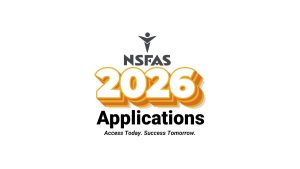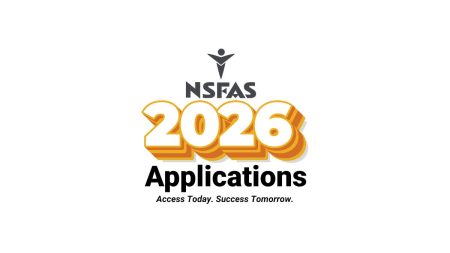The 2024 NFSAS applications are officially open. As applications continue to pour in, it is important to note and know what your NSFAS application status and outcomes mean so you can take the necessary next steps to ensure your funding is secured.
Understanding NSFAS Application Status Outcomes and Next Steps
Each update in your NSFAS application status is a step forward towards securing financial aid. Here is how you can ensure your application progresses effectively at each stage:
1. ‘Application Received’ Status

When you see the “Application Submitted” status on your NSFAS application status, it means your journey to funding has begun. This status is the initial step that confirms your application has been successfully received and is active in the NSFAS system.
Meaning of “Application Submitted”
This status confirms that NSFAS has received your application. It means that all the initial steps of filling out the application form and uploading documents have been completed correctly. Your application has been fully loaded onto the NSFAS system and is now in the queue for the next stages of processing.
What Happens in This Stage?
At this point, your application details are being captured in the NSFAS database. This is a crucial step as it ensures that all your submitted information is accurately recorded in the system. Although a detailed review has not yet begun, NSFAS may start initial checks to ensure application completeness and basic eligibility.
Next Steps for Applicants:
- Confirmation Email/SMS: Look out for a confirmation email or SMS from NSFAS. This is an additional acknowledgment of your application submission.
- Record Keeping: Keep a note of your application reference number. This number is crucial for any future queries or follow-ups with NSFAS.
- Patience: Since this is just the beginning of the process, patience is key. Processing times can vary depending on the volume of applications NSFAS receives.
Estimated Time for This Stage
The duration of the “Application Submitted” stage can vary. Typically, it may last a few days to a couple of weeks before moving to the next status. During peak application periods, this time frame could be longer.
Monitoring Progress:
It is advisable to regularly check the NSFAS portal for any updates on your application status. Keep an eye on official NSFAS communications for any general updates or announcements regarding the application process.
If Status Doesn’t Change:
If your NSFAS application status remains unchanged for an unusually long period, consider contacting NSFAS for an update. Sometimes, system glitches or high volumes can cause delays in status updates.
2. Application Processing: Filtering

The “Filtering” outcome in your NSFAS application status is a crucial step in the processing of your application. This stage involves NSFAS assessing whether you are a first-time applicant or a returning student, and it has significant implications for how your application is handled.
Understanding “Filtering” NSFAS Application Status
The primary goal during the filtering stage is to categorize applicants into first-time students or returning students. This classification is vital as it dictates the subsequent processing steps for each application. NSFAS reviews its records to verify your academic history and any previous interactions with the scheme. This includes checking if you have previously received NSFAS funding.
Implications for Different Types of Applicants:
- First-Time Students:
For first-time applicants, NSFAS will conduct a fresh assessment of eligibility, including financial and academic criteria. Ensure that all your submitted documents, especially those proving your status as a first-time student, are accurate and complete.
- Returning Students:
If you are a returning student, NSFAS will review your past funding history. This includes assessing if you have met the necessary academic progress requirements to continue receiving funding. It is crucial for returning students to update any changed information, like academic results or financial status, to ensure accurate processing.
Turnaround Time for “Filtering”:
The duration of this NSFAS application status can vary. Typically, it takes a few days to a week but can extend longer during peak periods or if there are complexities in an individual’s academic history. This stage is relatively quicker compared to other stages as it involves categorizing rather than a detailed evaluation of the application.
Next Steps for Applicants:
- Stay Updated: Regularly check your NSFAS application status for any changes or updates post the filtering stage.
- Be Responsive: If NSFAS requests additional information or clarification during this stage, respond promptly to avoid delays in your application process.
- Keep Records Handy: Have your academic records and any previous NSFAS communication accessible in case they are needed for reference or clarification.
Importance of “Filtering” Stage:
The filtering stage sets the groundwork for how your application will be processed in the subsequent stages. Ensuring the accuracy of your status (first-time or returning student) is critical as it affects eligibility and the type of funding you may receive.
3. Validation Stage

The “Validation” outcome in your NSFAS application status represents a critical verification process. During this stage, NSFAS collaborates with third-party entities like the South African Social Security Agency (SASSA) and the Department of Home Affairs to authenticate the information you have provided.
Role of SASSA and the Department of Home Affairs:
- Cross-Verification: SASSA and the Department of Home Affairs play a pivotal role in confirming your socio-economic and identity data. This includes validating your identity, household income, and any social grants your family might be receiving.
- Data Consistency: The validation process ensures that the information across different government databases is consistent with what you have submitted in your NSFAS application.
Implications of SASSA Funding:
- NSFAS and SASSA Relationship: It is important to understand the relationship between NSFAS and SASSA funding. While you are ineligible for NSFAS funding if you are already receiving SASSA funding, the reverse is not true. Receiving SASSA funding does not disqualify you from NSFAS funding.
- Financial Need Assessment: NSFAS views SASSA grants as part of the household’s financial resources. This information is used to assess the level of financial need for educational support.
Duration of the Validation Stage:
- Time-Frame: The validation process can take several weeks, as it involves thorough checks and coordination between multiple government agencies.
- Waiting Period: Applicants should be prepared for this stage to take longer than others, due to the depth of verification required.
What Applicants Can Do During This Stage:
- Documentation Accuracy: Ensure that all your submitted information aligns with government records. Discrepancies can cause delays or issues in the validation process.
- Regular Status Checks: Keep checking your NSFAS application status to track the progress of your application. Be patient as the validation process is thorough and can take time.
- Prepare for Possible Queries: Be ready to respond to any queries from NSFAS or provide additional information if there are discrepancies or if more clarity is needed.
Importance of Validation:
- Ensuring Fair Distribution of Funds: The validation stage is crucial for ensuring that NSFAS funds are allocated to the most deserving students. It helps prevent fraudulent applications and ensures equity in the distribution of financial aid.
- Confirming Applicant Eligibility: This stage is essential in confirming that applicants meet all the necessary criteria for funding, including financial need and academic eligibility.
4. Evaluation Stage

The “Evaluation” outcome in your NSFAS application status is a critical phase where NSFAS meticulously reviews and verifies the supporting documents you have submitted. This stage is essential in determining your eligibility for financial aid.
Purpose of the “Evaluation” Stage:
- Thorough Document Review: During this stage, NSFAS scrutinizes each document for its authenticity, relevance, and compliance with NSFAS requirements.
- Verification of Information: The accuracy of your personal information, academic records, and financial details is thoroughly checked.
Types of Documents Evaluated:
- Personal Identification Documents: This includes your ID document, birth certificate, or passport.
- Academic Records: Your previous academic achievements, matriculation results, and any tertiary academic records are reviewed.
- Financial Documents: Proof of household income, such as payslips, employment letters, or affidavits in cases of unemployment, are verified to assess financial need.
- Additional Documentation: This may include disability assessments for students with disabilities, death certificates for orphaned students, or other relevant documents based on individual circumstances.
Related: NSFAS 2024 Applications Eligibility Criteria
Process and Attention to Detail:
- Cross-Verification: NSFAS may cross-reference your information with other databases and agencies, such as the Department of Home Affairs, SARS, and educational institutions.
- Quality Checks: Each document is checked for clarity, validity, and completeness. Blurred or incomplete documents can lead to requests for resubmission, thus delaying the process.
Duration of the “Evaluation” Stage:
- Varied Time Frame: The time taken for the Evaluation stage can vary significantly, typically ranging from a few weeks to a couple of months. The duration depends on the complexity of the application and the workload of NSFAS during the application period.
- Peak Period Delays: During high application periods, such as just before the start of a new academic year, processing times may be longer due to the increased volume of applications.
Applicant Actions During Evaluation:
- Monitoring Status: Regularly check your NSFAS portal for any updates or changes in status.
- Responsive Action: If NSFAS requests additional documents or clarifications, respond promptly and accurately.
- Stay Informed: Keep abreast of NSFAS announcements or changes in application requirements that might impact your evaluation process.
Significance of the “Evaluation” Stage:
- Determines Eligibility: This stage is crucial as it directly impacts your eligibility for NSFAS funding.
- Accuracy and Transparency: Ensuring that your documents are accurate and transparent can expedite the evaluation process and increase your chances of receiving funding.
5. Funding Eligibility

Financial eligibility is a crucial component of the NSFAS application status process. It determines whether a student’s financial background meets the requirements set by NSFAS for receiving funding.
Financial Threshold:
- Income Cap: For a student to qualify for NSFAS funding, the combined household income must not exceed R350,000 per year. This threshold is set to ensure that funding is allocated to students who need it the most.
- Special Consideration: Students with disabilities have a higher income threshold. For these students, the household income must not exceed R600,000 per annum.
Verification Process:
- Income Assessment: NSFAS conducts a thorough assessment of your household income. This includes checking the income of parents or guardians.
- Required Documentation: You may need to submit payslips, employment letters, or other official documents that verify household income. In the case of unemployed parents or guardians, an affidavit stating their unemployment might be required.
- Third-Party Checks: NSFAS may also use third-party agencies to verify the income information provided. This could include cross-referencing with SARS (South African Revenue Service) data.
Other Considerations:
- Total Family Contribution: The assessment considers the total family income, not just the income of the primary breadwinner. This means all working members of the family contribute to the total household income calculation.
- Annual Update: It’s important to note that financial eligibility is reassessed every year. Changes in your family’s financial situation must be reported to NSFAS as they can affect your funding eligibility.
What Happens If You Exceed the Threshold?
- Ineligibility for NSFAS: If your household income is above the threshold, you will not qualify for NSFAS funding. However, there are other financial aid options available, such as bursaries, scholarships, and student loans from banks or private institutions.
- Appeals Process: In cases where there are extenuating circumstances or significant changes in financial status, students can appeal NSFAS’s decision with relevant and updated documentation.
6. Awaiting Academic Results / Admissions

The “Awaiting Academic Results/Admissions” stage in your NSFAS application status is a pivotal phase where NSFAS awaits confirmation of your academic performance and admission status from the educational institution you applied to. This stage is crucial, as it aligns your NSFAS application with your academic journey. Here’s an expanded understanding of what this stage entails:
Significance of “Awaiting Academic Results/Admissions ” NFAS Application Status:
- Academic Performance Review: NSFAS checks your academic records to ensure you meet the required performance criteria.
- Admission Confirmation: This status also indicates that NSFAS is awaiting confirmation from your chosen institution regarding your acceptance or current enrollment.
Process and Implications:
- Communication Between NSFAS and Institutions:
- NSFAS coordinates with educational institutions to verify your admission status.
- The confirmation of your enrollment is a key factor that NSFAS considers before finalizing your funding approval.
- Your Role in Communication:
- Inform NSFAS: If you receive admission from an institution, it’s important to communicate this to NSFAS. This can be done through the NSFAS portal or as directed in NSFAS communication.
- Update Application Details: Ensure that your NSFAS application includes the correct details of the institution and the course you have been admitted to.
- University’s Role:
- Once your university or college confirms your admission status to NSFAS, it acts as a green light for NSFAS to proceed with the final steps of your application.
Time Frame:
- Dependent on External Factors: The duration of this stage largely depends on the response time of the educational institution. It can range from a few days to several weeks.
- Proactive Follow-Up: If there’s a significant delay, it is advisable to follow up with both the educational institution and NSFAS to ensure there are no miscommunications or overlooked details.
Final Steps Post Confirmation:
- Funding Approval: Upon receiving confirmation from the institution, NSFAS will move towards finalizing your funding decision.
- Notification of Outcome: You will be notified of the final decision regarding your NSFAS funding through the portal, email, or SMS.
Importance of this Stage:
- Determines Funding Outcome: This stage is critical as it correlates your academic and financial aid aspects, ensuring that NSFAS funding is aligned with your academic progress and enrollment status.
- Accuracy in Details: It is imperative to ensure that all details related to your institution and course are accurately reflected in your NSFAS application to avoid any discrepancies.
7. Awaiting Registration
The “Awaiting Registration” stage in your NSFAS application status is an essential phase where NSFAS is waiting to receive your registration details from the educational institution you’ve been accepted into. This stage is vital for the final approval and release of your funding. Here’s a more detailed explanation of what this status entails and its implications:
Understanding the “Awaiting Registration” NSFAS Application Status:
- Meaning: This status appears when NSFAS has processed your application, and you are provisionally approved for funding, but the scheme is yet to receive confirmation of your registration at the educational institution.
- Dependence on Institution: NSFAS relies on your institution to submit your registration details. Without this information, NSFAS cannot finalize your bursary arrangement.
Role of Educational Institutions:
- Submission of Registration Details: Institutions are responsible for sending the registration data of all NSFAS-funded students to the scheme. This includes information about the course you are registered for and the registration fees.
- Institutional Deadlines: Each institution has its own timeline for submitting these details to NSFAS. Understanding these timelines can help you gauge how long the “Awaiting Registration” status might last.
Implications for Funding:
- Funding Activation: The submission of registration details is a crucial step for the activation of your NSFAS funding. Without this, NSFAS cannot disburse the funds meant for your tuition and related expenses.
- Impact on Financial Aid: Delays in submitting registration details by the institution can lead to delays in the release of your funding, impacting your ability to start or continue your studies without financial stress.
Actions You Can Take:
- Follow Up with Institution: If the “Awaiting Registration” status persists, it is advisable to check with your institution’s financial aid office to ensure that your registration details have been sent to NSFAS.
- Keep NSFAS Informed: If there are any issues or delays at your institution’s end, communicate this to NSFAS through their customer service channels.
Time Frame for “Awaiting Registration”:
- Varies by Institution: The time taken to clear this status can vary based on how promptly your institution submits the required information. Generally, it can take a few days to a couple of weeks after the registration process at the institution is complete.
Importance of the “Awaiting Registration” Stage:
- Final Gateway to Funding: This stage is the final step before your NSFAS funding is officially sanctioned and disbursed.
- Ensuring a Smooth Transition: Timely registration and prompt communication of registration details by the institution ensure a smooth transition into your academic year without funding hiccups.
8. Signing Agreement

When your NSFAS application status shows “Signing Agreement,” it indicates a critical stage where your acceptance of the NSFAS bursary is formalized through a contract. This stage is the final confirmation of your funding and involves legal acknowledgment of the terms and conditions associated with the NSFAS bursary.
Understanding “Signing Agreement” Status:
- Bursary Contract: At this point, NSFAS has approved your application for funding, and the next step is for you to officially accept the bursary by signing a contract.
- Legal Formality: This contract is a legally binding document that outlines the terms, conditions, and obligations associated with the NSFAS funding.
Process of Signing the Agreement:
- Receiving the Contract:
- NSFAS will provide you with the Bursary Agreement Form, usually through their online portal or via email.
- Carefully review all the terms and conditions in the agreement before signing.
- Understanding the Terms:
- The agreement will detail your obligations as a bursary recipient, including academic performance requirements and any other conditions set by NSFAS.
- It’s essential to understand these terms, as they will affect your eligibility to continue receiving funding throughout your studies.
- Digital Signature:
- Most often, the signing process is done electronically through the NSFAS portal.
- Ensure your contact details are updated in the NSFAS system, as this can affect the delivery and confirmation of your signed agreement.
Importance of Timely Signing:
- Release of Funds: Your NSFAS allowances, such as tuition fees, accommodation, and learning material allowances, will only be disbursed after the agreement is signed.
- Delays in Signing: Delay in signing the agreement can result in delays in receiving your funding, which can impact your ability to pay for tuition and other educational expenses.
Time Frame for Signing:
- Prompt Action Required: Once you receive the contract, it is advisable to sign and return it as quickly as possible. Generally, a window is provided (often a few weeks) for you to complete this process.
Post Signing Steps:
- Confirmation of Signing: After signing, you should receive a confirmation from NSFAS, acknowledging the receipt of your signed agreement.
- Monitoring Disbursements: Keep track of the disbursements of your allowances as per the schedule provided by NSFAS.
Signing Agreement – A Critical Step:
- Commitment to Compliance: By signing the agreement, you commit to complying with the NSFAS requirements and conditions for the duration of your studies.
- Understanding Implications: Be aware of the implications of not adhering to the agreement, such as the possibility of having to repay the funding or losing future funding eligibility.
9. Payments

When your NSFAS application status updates to “Payment,” it signifies a pivotal moment in your NSFAS application status journey. This status indicates that the funds allocated to you have been disbursed and are now available for use. Here’s an expanded view of what the “Payment” status entails and its implications for your academic and financial planning:
Meaning of “Payment” NSFAS application Status:
- Fund Disbursement: This status confirms that NSFAS has processed and released your funding. The funds are typically allocated for tuition, accommodation, learning materials, and living allowances, depending on your specific bursary agreement.
- Accessibility of Funds: The funds are usually made available either directly to your institution to cover tuition and fees or are deposited into your NSFAS wallet or bank account for personal educational expenses.
How to Access and Use Your Funds:
- NSFAS Wallet:
- For personal allowances, NSFAS may use a system called the NSFAS Wallet. You can withdraw cash or transact using this wallet at NSFAS-partnered merchants.
- Familiarize yourself with how the NSFAS Wallet works, including setting up your account, accessing funds, and transaction limits.
- Direct Payments to Institutions:
- Tuition and accommodation fees are often paid directly to the institutions. Ensure that these payments have been accurately made by checking with your institution’s financial office.
- Keep records of all transactions and payments for future reference.
- Usage Guidelines:
- Use the funds as intended – for educational purposes. This includes tuition fees, books, learning materials, accommodation, and living expenses.
- Misuse of funds can lead to serious consequences, including the termination of funding.
Monitoring Your Funds:
- Regular Check: Keep track of your fund disbursement and usage. Regularly check your NSFAS Wallet or bank account to monitor incoming payments and expenditures.
- Receipts and Statements: Save all receipts and statements related to your educational expenses. This is important for maintaining a record of how the funds are utilized.
Importance of Timely Payment:
- Academic Continuity: Timely disbursement of funds ensures that you can pay for your educational expenses without interruption, aiding in a smooth academic journey.
- Financial Planning: Knowing that your funds have been paid allows you to plan your budget effectively for the academic year.
In Case of Payment Issues:
- Contact NSFAS: If there are delays or discrepancies in the payment, contact NSFAS immediately for clarification and resolution.
- Liaise with Institution: In cases of direct payments to institutions, coordinate with your institution’s financial aid office to resolve any issues.
Addressing Incomplete or Rejected NSFAS Application Status
Receiving an ‘Incomplete’ or ‘Rejected’ outcome on your NSFAS application status can be disheartening, but it is often a situation that can be rectified with the right steps.
Understanding the Status:
- Incomplete Application: This status generally means that some critical part of your application is missing or not properly submitted. Common reasons include missing documents, incomplete forms, or unclear/inaccurate information.
- Rejected Application: A rejection implies that your application does not meet one or more of NSFAS’s eligibility criteria. Reasons for rejection can range from surpassing the financial eligibility threshold to insufficient academic performance.
Steps to Take:
- Seek Clarification:
Reach out to the NSFAS support center for specific reasons behind the negative NSFAS application status. Get clear information on what is missing or the reason for rejection.
- Prepare Required Documentation:
If your application is incomplete, identify and compile all missing documents as indicated by NSFAS application status. Ensure that all information is accurate and up-to-date. Errors in personal details or financial information can lead to application rejection.
- Resubmit or Appeal:
- Resubmission for Incomplete Applications: Once you have all necessary documents, resubmit your application promptly.
- Appeal Process for Rejections: If your application is rejected, and you believe it was in error or due to circumstances that have since changed, file an appeal. Include any supporting documents that justify your case.
- Follow Up Regularly:
- Track Your Application: After resubmitting or appealing, regularly check your NSFAS application status.
Additional Tips
- Stay Informed: Keep abreast of any changes in NSFAS policies or application procedures.
- Deadlines: Adhere strictly to application deadlines to avoid disappointment.
- Queries and Concerns: If you have any doubts or notice any discrepancies in your NSFAS application status, don’t hesitate to contact NSFAS directly. Their customer service is geared towards assisting students with any application-related queries.
- Email and SMS Updates: Apart from the portal, NSFAS also communicates important updates through emails and SMS. Ensure that your contact details are up to date in the NSFAS system to receive these notifications promptly.
- Portal Check: Regularly check your NSFAS application status online for updates on your reapplication.
- Academic Results: Submit your latest academic results as soon as they are available to avoid delays in processing your reapplication.
- Processing Time: Remember, the processing of NSFAS application status can take time, especially during peak periods. Patience is vital while your application is being processed.
- Record Keeping: Keep copies of all communications and submissions made to NSFAS for your records.
Navigating through the NSFAS application status tracker can be a complex process, but with proper guidance and understanding, it becomes manageable. Whether you are a new applicant or a returning student, staying informed and proactive about your NSFAS application status and outcomes is key to ensuring your educational journey is uninterrupted in 2024.











